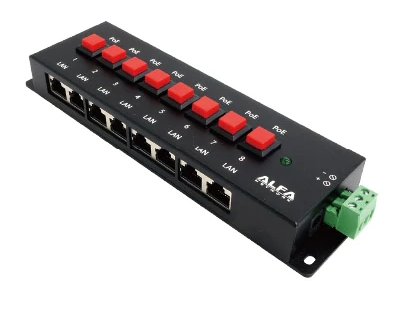Power over Ethernet (PoE) Basics - Active POE
Power over Ethernet (PoE) is a technology initially introduced by Cisco in the early 2000s. It enables the transmission of electrical power alongside data signals over standard Ethernet cables. It allows network devices, such as IP phones, wireless access points, Point-of-Sale devices, and security cameras, to receive power directly from a PoE-enabled network switch or injector, eliminating the need for separate power cables.
 APoE08G
APoE08G
There are two term to familiarize with before beginning our discussion, these are the IEEE 802.3 categorizations for power device types:
- Power Sourcing Equipment (PSE) - any electronic device that provides electrical power over standard ethernet cables (Cat 5, 6, 7 etc.) to a PoE enabled device.
- Powered Device (PD) - this is any electronic device that is powered via PoE (any device powered by a PSE).
Broadly put we have two major categorizations for PoE:
Refers to any type of PoE that will perform a negotiation between the power supply equipment and the powered device. It will only relay power when the PD requests for it, transmitting at the negotiated voltage and power required by the device. The implication is that your non - PoE devices are safe when connected to an active PSE.
The power available for use is typically between 15W - 100W, which is enough for many use cases.
The standards under active PoE are regulated by the IEEE 802.3 standards to enforce compatibility among the different manufacturers. A PSE might be a midspan (PoE injector) or endspan (PoE network switch) device.
- Passive/ Non-Standard PoE
It can lightly be referred to as an old school standard. It delivers PoE to the PD but without a handshake (negotiation), the PSE will just consistently transmit its available power irrespective of device requirements. It's not covered by the IEEE 802.3 working group standards.
These will be devices such as wireless access points, VoIP phones, security cameras, Point of Sale devices etc.
Related Articles
IEEE 802.3 Active Power over Ethernet Standards
There are several standards for Active/ Standard POE, which specify the maximum amount of power that can be delivered over Ethernet cables. Here is a list of some popular PoE midspan and endspan devices for your consideration. Unifi Active PoE Switch ...Frequently Asked Questions: Streetlight Power Tap Adapters
A streetlight power tap adapter is a device that allows you to tap into the power supply of a streetlight. It installs between the ANSI C136.10 receptacle on top of the luminaire and the photocell without interfering with normal photocontrol ...Streetlight Power Tap Operations Basics
Power Tap Basics A power tap allows the use of existing light pole infrastructure to power auxiliary equipment like wireless access points, CCTV cameras, sensors, routers, and gateways etc. It taps into the power supply of a streetlight by connecting ...Dusk to Dawn Streetlight Power for Outdoor Decorative Lights
Outdoor decorative/ holiday lights have the ability to convert regular spaces into warm, safe and inviting landscapes; consistently serving as sources of beauty and inspiration within communities during the festive season. It is true that most, if ...Powering the TP-Link EAP225 Access Point with the FP288A-120-BBN-A Streetlight Power Tap
The TP-Link EAP225-Outdoor is a high-performance AC1200 Wireless MU-MIMO Gigabit Access Point crafted to deliver dependable dual-band Wi-Fi for indoor and outdoor applications. With maximum speeds of 300 Mbps on the 2.4GHz frequency and 867 Mbps on ...